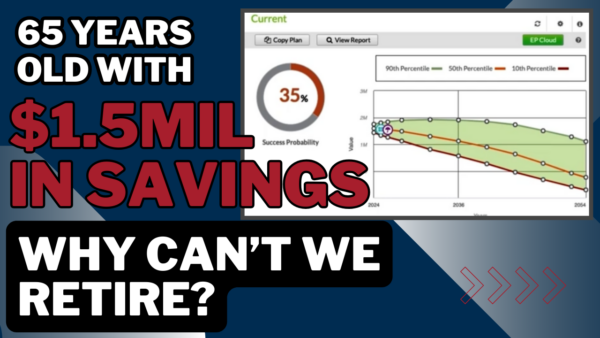What do you do when you have enough retirement income but also extra pre-tax money growing on the sidelines?
People are living longer now, so the need of funds for medical care is more important than ever. You may know a family member or friend who’s had some problems with medical care and understands the strain that comes with that challenge.
A pre-tax account, like an IRA, can be a great tool; but, like any tool, if it’s used for the wrong job, it’s a bad tool.
If you’re planning to use this pre-tax account for either of these purposes, you may be missing an opportunity. Did you know that a $100,000 IRA may end up only being worth $65,000 to your loved ones when you pass? Did you know that even if you’re looking to use that pre-tax account for long-term care, distributions from that pre-tax account could 100% taxable to you as income?
It’s important that your money can:
- Be accessible tax-free for long-term care/medical care costs
- Provide a larger after-tax inheritance to your loved ones.
If you’re age 65 or older, you stand a 70% chance of needing some form of long-term medical care during your lifetime.1
- On average, people who need long-term medical care typically need it for at least three years.1
- The average cost for a semiprivate room, according to a 2017 national survey, is $85,776 per year.2
- If you need three years of care in a semi-private room, that’s $257,328 in unplanned medical expenses, beyond your normal retirement income need.
That’s why you need to ask yourself: Which asset goes first? You’ll need to pay for any needed care somehow.3 Since Medicare only covers certain care needs for a short period of time, you may have to liquidate some of your retirement accounts to pay for this type of medical care need.
But, what if there was another way to help cover unexpected medical costs, AND help in protecting your financial independence? What if an insurance policy with an optional rider could provide added contractual guarantees and tax-free benefits?
Few pre-retirees and retirees fully appreciate the danger a long-term medical care scenario can pose to their retirement lifestyle. This is largely due to a few BIG misconceptions:
1) They Don’t Think They Need It
Many folks age 65 and older don’t think they’ll need long-term care coverage, or they think they’ll have enough set aside to handle any costs. The U.S. Department of Health and Human Services claims that almost 70% of people turning 65 will need long-term care at some point in their lives.4 In the year 2016 alone, an NAIC study estimated that 12 million people had some level of long-term care need in the United States.5
2) They Think Medicare Will Cover Long-Term Care Expenses
The amount of long-term care Medicare may provide you is limited in both benefit and the time it’s available. Generally, Medicare may cover 100% of your first 20 days in a long-term care facility. For days 21-100, Medicare may cover a portion of the expenses, leaving you with a co-pay that could impact your retirement savings. After day 100 in a facility, Medicare stops, and you assume all expenses. You’ll have to cover the full cost of any care from this point on.6
Imagine having to pay out about $7K every month from your retirement assets to cover a semi-private room in a facility or paying $4K every month for a home health aide. These were averages in 2017, and medical care costs have continued to rise since then.7
3) They Believe Family Will Be Able To Help If Anything Happens
A 2015 study from the AARP Public Policy Institute reported that some 43.5 million Americans served as family caregivers that year alone.8 Most of these caregivers are spouses or children. Beyond the stress and emotional strain that caring for a loved one produces, it could also affect the ability of the caregivers to prepare for their own retirement. In a 2011 study, MetLife found that caregivers of parents (predominantly baby boomers) had lost nearly $3 trillion in wages and retirement benefits in their lifetimes.9 This is due to them taking time off work, decreasing their wages and future Social Security benefits.
4) They Think “If I Don’t Use It, I Lose It”
Many baby boomers think of outdated long-term care policies when they hear about long-term care insurance. The fact is, some products offer full return of premium, a tax-free death benefit, and a tax-free long-term care bucket that’s accessible when they need it.
For example, let’s take a 65-year-old man with an additional annual income of $10,000 that he isn’t using for living expenses and who has no long-term care protection. By using an asset-based long-term care product, he could pay $10,000 per year for 10 years.
He gets a total guaranteed long-term care benefit of $322,575 that he can access over a six-year period. That’s $4,480 per month to help with qualified care, including home health care. He finishes paying the premium for 10 years, and at the end of year 11, he has full return of premium. Since the policy is fully vested, he can walk away with his money at any time.
If you are looking to forge your own path and not rely on government help if medical care endangers your retirement lifestyle, make sure you have that conversation with a financial professional. Be sure to ask how you can protect your financial future if long-term medical care costs arise.
Sources:
1 https://longtermcare.acl.gov/the-basics/how-much-care-will-you-need.html
2 https://www.genworth.com/aging-and-you/finances/cost-of-care.html
3 https://longtermcare.acl.gov/the-basics/who-pays-for-long-term-care.html
4 https://longtermcare.acl.gov/the-basics/how-much-care-will-you-need.html
5 https://www.naic.org/documents/cipr_current_study_160519_ltc_insurance.pdf
6 https://www.medicare.gov/Pubs/pdf/10153.pdf
7 https://www.genworth.com/aging-and-you/finances/cost-of-care.html
8 https://www.aarp.org/content/dam/aarp/ppi/2015/caregiving-in-the-united-states-2015-report-revised.pdf
9 https://www.caregiving.org/wp-content/uploads/2011/06/mmi-caregiving-costs-working-caregivers.pdf


